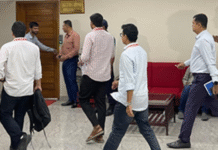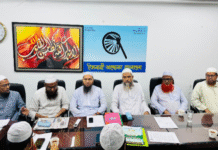The more things change, the more they stay the same: How Bengal poll violence proves this again and again
As powers came and went, the myth became a conviction that the ruling party in Bengal controls polls.
Why are Bengal polls always bloody and violent?
Bengalis, all said and done are a tolerant race: tolerant to its tradition and legacy until a point and are sloth to being otherwise.
For the last four decades, Bengal has witnessed violent polls, political murders, heavy casualties, and the unleashing of goondaraj by the ruling party to help it win poll after poll, year after year.
Bengalis have borne it for years, much too long for three decades, to finally come out of their temperate and tolerant shell to change the people at helms — the powers that be — who’ve deprived them of their democratic rights in places.
The year 2011 saw the end of 35 years of the Communist rule in Bengal and it was hoped that it would end many things: the Bengali’s dilemma to dare and defy, dithering to dream and the defeatist attitude of succumbing to forces, if found beyond control, as if it were destined.
But as the years rolled on and the power at the helms showed its claws and teeth, Bengalis slithered back to its shell of endurance: tolerating things.
Elections repeated its history of massive violence, leaving behind the usual bloody trail.
The last eight years of the Trinamool Congress regime were no different.
 Bengal has topped the chart in casualties and deaths in poll-related violence. (Photo: PTI file)
Bengal has topped the chart in casualties and deaths in poll-related violence. (Photo: PTI file)
Intimidation and threat dominated the poll climate and musclemen and leaders at the seat of power threw their weight around during polls, making a mockery of democracy.
The 2018 panchayat polls which did not allow the Opposition to contest in 34% seats and eventually barred 1.5 crore people from taking part in the biggest festival of democracy, saw tolerance at its pitiable and pathetic state.
Perhaps having peaked the zenith and reaching a stage where all tethers of forbearance crashed, tolerance rebelled.
From the very beginning of the 2019 general elections, voters in Bengal came across as ready to be intolerant to what was going around: deliberate muzzling of voices of dissent and expression of democratic rights. They made it clear that their tolerance should not be taken for granted or mistaken for weakness. People were preparing the ground when a political party, such as the BJP, sensing an opportunity to have footfall, overriding on the mood of intolerance, offered to back them in their fight for democracy.
The BJP, by virtue of being at the Centre, promised a free and fair election in the presence of armed central forces, which would not only stop muscle-flexing, blood spills and minimise the shooting barometer of fear, but will also ensure people to select the party of their choice by exercising their voting rights.
Close to one-third of the rural population, who could not have representatives of their own selection, was naturally happy.
The general election, touted as one big battle for restoring democracy, saw people on the streets, ready to face and fight the wrath of the ruling party and its henchmen.
Women could be seen coming out in large numbers with every possible domestic appliance — jhata (broomstick), bnoti (a kind of a chopper to cut vegetables) — to stop the goons from booth jamming, rigging and vote-looting.
The central forces were heavily deployed, but only in an official notification — not on the ground.
As always and strictly going by the rule-book of tradition, the state police and administration did as was expected of them: being loyal and obedient to their authorities, following the diktat.
Central forces were under-deployed, whereas goons in alleged army outfit ran amok creating chaos and confusion.
As powers came and went, the myth became a conviction that the ruling party in Bengal, with the administrative machinery by its side, conducted and controlled the polls, turning people’s mandate into a farce.
“This has been largely possible because of politicisation of administration, which you would not find anywhere. Here state police and police superintendents run the show, they take the ultimate call on where and how to put the Central forces in use. In the past under Left Front regime too we have seen how Central forces were made to do route march before the polls and sit on the reserve bench on the day of the polls,” said a retired home department official, requesting anonymity.
The legacy rolls on.
There are exceptions — police, bureaucrats and musclemen refusing to toe in the line when, like weathercocks, they feel the wind shifting.
“Nowhere in the country will you observe so much violence. It used to be once upon a time in Bihar and Uttar Pradesh, but not anymore,” said poll analyst Biswanath Chakrabarty.
But Bengal has faithfully allowed the tradition of rigging and poll violence to remain.
Just after the first phase of the polls, when a special observer pointed out that Bengal has gone back to the old Bihar days, the Bengal chief minister sniggered and so did the Bengali pride.
But after the six phases of polls, Bengal has topped the chart in casualties, deaths (three) on the days of the polls, and in the number of injured in pre- and post-poll violence. A person associated closely with the ruling party admitted that this time there’s a strong wind in favour of the saffron party.
But being in the administration and with all power, resources, and machinery in hand, the ruling Trinamool Congress is at an advantage to win hands down. It is sad that for all tall claims of democracy, Bengal has seldom allowed its people to celebrate the polling day as the festival of democracy.
(Courtesy of Mail Today)









